Pilot Study with Neuro Synchrony Institute (2015 & 2017)
Electrodermal Activity during a Zero Balancing bodywork session: An exploratory study of synchronous behaviour and evaluation of the objective, measurable physiological changes, such as stress, that occur during a 30-minute Zero Balancing bodywork session.
Stuart Reynolds, Ph.D. & James Strickland
Measured stress was reduced by over 60% when a client received a 30-minute Zero Balancing session, compared to a reduction of only 12% during an equivalent resting period.
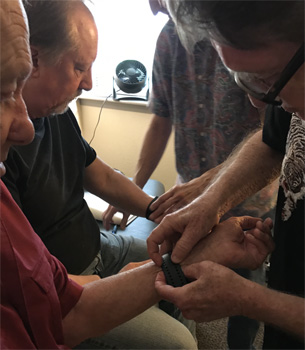
Leading the initial research were Dr. Stuart Reynolds and James Strickland, of the NeuroSynchrony Institute (NSI), a highly-regarded research institute based in Austin, Texas that was established to bridge the gap between behavioral and physiological research in real-world settings. These activities brought them into contact with a variety of different groups, including the ZB Touch Foundation.
These two researchers found Zero Balancing intriguing, designing a pilot study in 2015 to check out that the equipment and methodologies needed to explore the physiology of a client during a ZB session. Their goal was to pinpoint any therapeutically significant moments and to determine if there were any periods of synchrony between the client and practitioner.
As a result of this pilot showing promising findings, the researchers went on to design a larger pilot in 2017 to collect physiological data during 30 x 30-minute individual ZB sessions. They focused on the collection of electro-dermal skin conductance (EDA), which is believed to isolate accurately sympathetic responses and differentiate emotional states (Henriques et al., 2013). When the sympathetic branch of the autonomic nervous system is activated (an increase in stress) sweat gland activity also increases, which in turn increases the electrical conductivity of the skin. As stress reduces in a person, the lower their skin conductance. The underlying principle is that an increase or decrease in stress will show up equally when used it in the same way as a standard polygraph test.
The pilot study was carried out by a volunteer team of seven Certified Zero Balancing practitioners working with 30 volunteers, all unfamiliar with receiving regular Zero Balancing sessions, and who were divided randomly into two groups. One group received a 30-minute ZB session followed by a 20-minute supine resting period with no other interventions. The other group reversed the order, by lying quietly first before having their ZB session. This afforded an opportunity to quantify how data collected during a Zero Balancing session compared with equivalent data collected while simply lying at rest.
During their sessions both clients and practitioners wore unobtrusive data collecting technology designed by MIT, Empatica E4 and Affectiva Q wrist monitors. As a consequence, the researchers were able to record individual EDA changes, heart rate, heart rate variability, temperature, blood volume and pulse metrics for both groups and then compare them for each session. These research sessions were also video-recorded by NSI so that significant changes in the physiological data could be cross-referenced accurately to what was happening in real time in that session.
In addition, before and after their ZB session, volunteers were also asked to complete a Likert-style wellbeing questionnaire, developed by Strickland& Reynolds (2017), to assess their perception of changes in their mental and emotional states. Using a scale of six choices for each, the ten questions covered categories such as wellness, positive attitude to life, happiness, anxiousness, mental clarity, harmony, pain, stress, tensions and energy levels, as well as space for written comments.
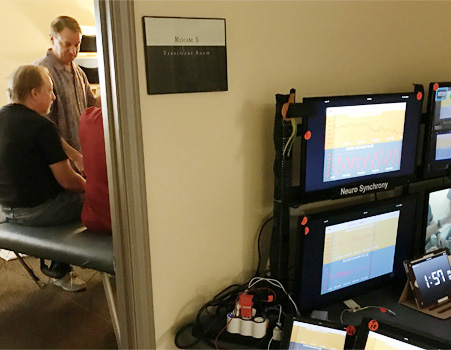
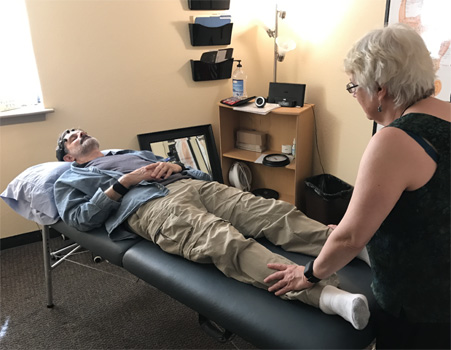
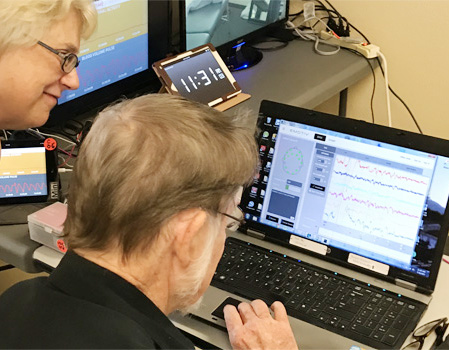
The initial findings were very exciting:
- Measured stress was reduced by over 60% when a client received a 30-minute Zero Balancing session, compared to a reduction of only 12% during an equivalent resting period.
- The sharpest fall in stress was associated with the first contact on the shins at the beginning of the ZB session. It was notable that skin conductance did not decrease in a linear way in keeping with a reduction of stress, but rather in a series of rhythmic waves with each wave usually cresting at a lower level than the last.
- Importantly, this significant measured reduction in stress was also observed in the clients’ responses to the questionnaires with every participant rating themselves more positively after a ZB session. The greatest positive differences were seen in a reduction of perceived tension and anxiety, and an overall feeling of being more relaxed.
- Video recordings and collected physiological data were correlated and compared to pinpoint therapeutically significant moments during each session, including the 20-minute rest period.
- Strickland & Reynolds (2018) considered the study data strongly suggested a powerful synchronicity with the client coming into a point of “zero balance” as they experienced the skilled touch of the practitioner. This interaction between the client and practitioner during a ZB session had an unusually high degree of synchrony compared to other interactions between individuals they had studied in other professional settings.
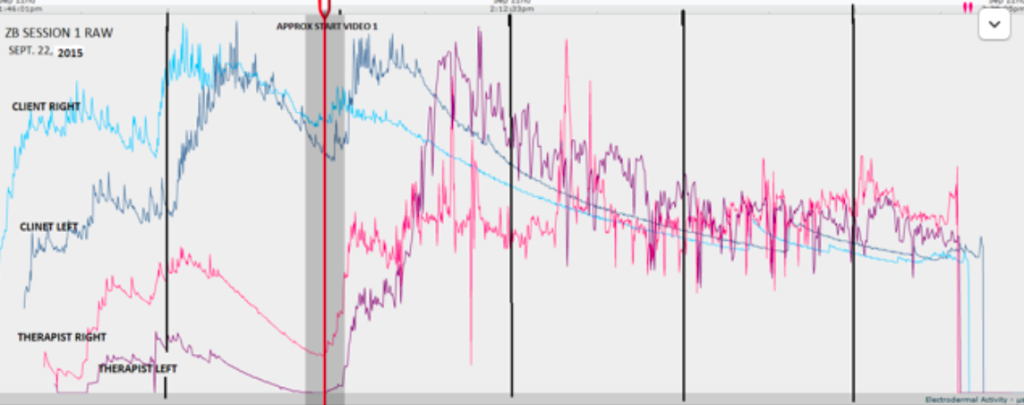
The vertical dark line on the graph indicates when the session started. The blue line represents the physiological data collected from the volunteer client and the red line the data collected from the ZB practitioner. You will see how the red line (practitioner) “seeks out” the blue line (client) to facilitate a connection with them. This concept is called interface in Zero Balancing.
- The client and practitioner were both observed to become quieter and quieter as the 30-minute session unfolded with their activation levels (blue & red lines) staying in close relationship until the session concluded. This is very much in keeping with what ZB practitioners anecdotally observe in their clients during a ZB session.
Strickland & Reynolds (2018) stated:
“This is one of the very few studies that takes on the challenging tasks of building bridges between bodywork and other behavioural health disciplines. This study represents a preliminary review although we can draw the following relevant conclusions:
-
Physiological changes in stress can be measured using unobtrusive wearable instrumentation
-
Zero Balancing techniques and working signs are detectable in physiological data
-
Physiological measures confirm client self-reports and observations that Zero Balancing is a stress reducing experience
-
All participants rated a positive emotional experience from pre- and post-questionnaires
-
Zero Balancing markedly reduced the perception of stress, tension and anxiety
-
Zero Balancing showed clients greater perceived feeling of wellness, positivity of self and others, mental clarity and harmony
-
We have such compelling data that it should be shared with others in the healing and health professions.”
One intriguing incident drew their particular attention. When the video camera tripod was inadvertently knocked over during a study session creating a loud bang, this unexpected noise did not appear to disturb the client. A normal startle response was not recorded in the graphs, i.e., the EDA and physiological data did not spike as would ordinarily be expected. This strongly suggested that the client was so “deep” in themselves they did not hear this noise consciously or unconsciously and that ZB Touch might be engendering a form of expanded consciousness within the client, not dissimilar to that experienced during mindfulness and meditative practices.
Such a significant reduction in stress levels, as was reported by this study, unequivocally demonstrates the huge potential of Zero Balancing to improve an individual’s overall health and wellbeing by reducing overexposure to cortisol and other stress hormones that can disrupt and compromise the immune system. When this is combined with an increased level of physical and mental equilibrium, as experienced during and after a ZB session, a powerful opportunity is created where conditioned stress responses are minimised and positive changes to lifestyle and behaviours are more likely to occur.
This study gives evidence-based confirmation of what has been observed by ZB practitioners and clients over many decades: that Zero Balancing has a clear potential to enable people to feel at ease with themselves and their environment increasing their sense of innate wellness.

